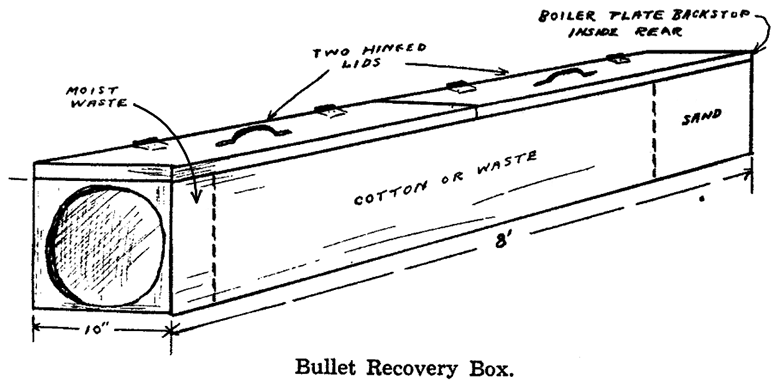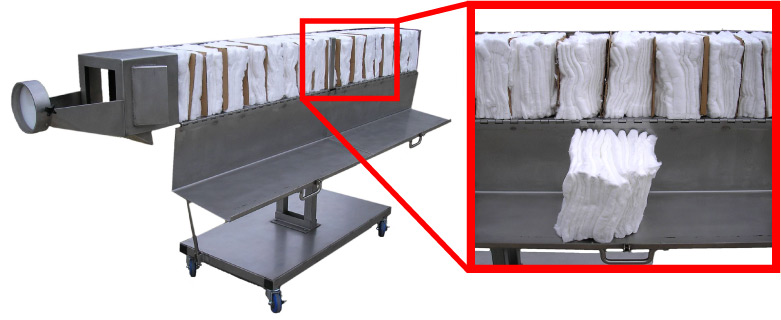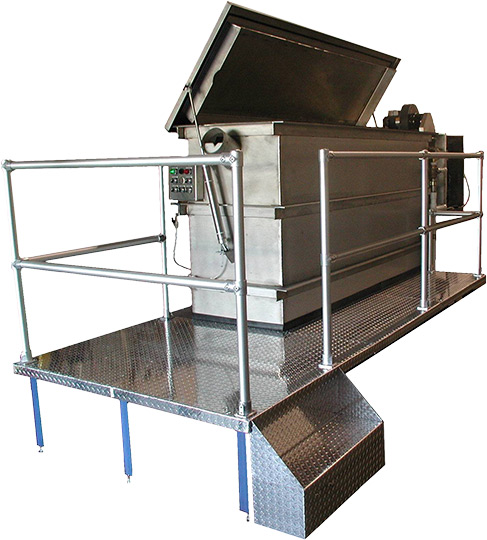Home | Glossary | Resources | Help | Contact Us | Course Map
Archival Notice
This is an archive page that is no longer being updated. It may contain outdated information and links may no longer function as originally intended.
Bullet Recovery Equipment
Obtaining test standards of fired ammunition components (bullets and cartridge cases) as a basis for comparison with the class and individual characteristics of evidence items is the first step in the identification process. Fired cartridge case collection is relatively simple. However, fired bullet samples must be collected using techniques that decelerate and securely capture the fired bullets within a short distance. The overarching requirement is that this be performed without damage to the microscopic detail on the surface of the fired bullets. A few basic types of recovery devices have evolved, including the cotton box and water recovery tanks.
Cotton Box
The traditional cotton box is usually constructed of wood or one-eighth to one-quarter inch thick metal plates. The box is typically approximately ten feet long and eighteen inches high and wide, with a hinged lid on the top and a firing port at one end. The box is filled with cotton waste material that decelerates bullets fired through the port.
The advantages of this type of bullet recovery apparatus are that it is
- simple,
- inexpensive,
- easily assembled from readily available materials using in-house agency resources.
Disadvantages:
- Requires a designated firing range
- May require considerable time to find fired bullets (all bullets must be found and removed to avoid confusion with other cases)
- Presents the potential for gunshot residues to ignite the cotton near the firing aperture
Water Recovery Tank
Initially, water recovery tanks were fabricated locally. The tanks were typically oriented horizontally and measured approximately ten feet long and five feet high. Water filled the tank to just below the firing port. The firing port was angled to facilitate shooting diagonally from the top edge of one end of the tank to the bottom of the opposite end. Indoor vertical tanks are generally not used as they are impractical.
The following points should be considered when constructing a horizontal water tank:
- The angle of the fired bullet should be approximately 30 to
- avoid ricochets off the surface of the water,
- minimize damage to the bullet.
- The bullet should travel a minimum of ten to twelve feet on the diagonal in order to decelerate most fired bullets.
- The tank should be positioned to facilitate firing at a 30 degree angle while allowing the shooter to maintain a comfortable shooting position.
- Tanks, which can weigh as much as five tons, should be located on the buildings ground level.
See the YouTube Terms of Service and Google Privacy Policy
Since the mid 1980s, commercial bullet recovery tanks have become available and have been found to be the optimum method for bullet recovery. The features of commercially available tanks may include the following:
- Stainless steel construction
- Underwater lighting to avoid surface reflection
- Water filtration and purification
- Air-tight lid and exhaust system
- Assisted lifting system to open the lid
- Nonskid shooting platform
- Secure drain system to preclude bullet loss
- Light colored interior finish to improve visibility
- Convenient work surface on shooting platform
- Connection to a floor drain
The space allocated for bullet recovery must address the same requirements as any other shooting facility, to include the following concerns:
- Adequate ventilation
- Sound mitigation
- A means for lead removal from bullet traps
- Periodic removal of accumulated surface lead from walls, ceilings, and floors
- A posted emergency plan for range users
- First aid equipment
- Periodic training of all personnel in first aid with special emphasis on gunshot wounds
- Periodic training of all personnel in mouth-to-mouth resuscitation
- Landlines to emergency response personnel and managers
- Baseline and periodic testing for lead levels in the blood for all personnel
- Baseline and periodic hearing tests for all personnel
- Availability of eye and hearing protection in the space
Additional Online Courses
- What Every First Responding Officer Should Know About DNA Evidence
- Collecting DNA Evidence at Property Crime Scenes
- DNA – A Prosecutor’s Practice Notebook
- Crime Scene and DNA Basics
- Laboratory Safety Programs
- DNA Amplification
- Population Genetics and Statistics
- Non-STR DNA Markers: SNPs, Y-STRs, LCN and mtDNA
- Firearms Examiner Training
- Forensic DNA Education for Law Enforcement Decisionmakers
- What Every Investigator and Evidence Technician Should Know About DNA Evidence
- Principles of Forensic DNA for Officers of the Court
- Law 101: Legal Guide for the Forensic Expert
- Laboratory Orientation and Testing of Body Fluids and Tissues
- DNA Extraction and Quantitation
- STR Data Analysis and Interpretation
- Communication Skills, Report Writing, and Courtroom Testimony
- Español for Law Enforcement
- Amplified DNA Product Separation for Forensic Analysts




